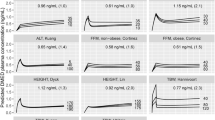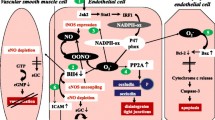Abstract
Sepsis is a systemic inflammatory response syndrome (SIRS) when an infection is the etiology of SIRS. Our previous studies have indicated that the release of the sympathetic neurotransmitter, norepinephrine (NE), from the gut is increased in sepsis, and that NE potentiates endotoxin-induced tumor necrosis factor (TNF)-α upregulation via the A subtype of α2-adrenoceptors (i.e., α2A-AR) expressed on the surface of Kupffer cells. A specific antagonist for α2A-AR, 2-[(4,5-dihydro-1H-imidazol-2-yl) methyl]-2,3-dihydro-1-methyl-1H-isoindole maleate (BRL-44408 maleate), reduces TNF-α secretion in cultured Kupffer cells. We, therefore, hypothesize that administration of BRL-44408 maleate inhibits inflammatory responses and reduces organ injury in sepsis. To study this, sepsis was induced in male rats by cecal ligation and puncture (CLP). At 5 h after CLP, BRL-44408 maleate (0.3125, 0.625, 1.25, 2.5, or 5.0 mg/kg BW) or vehicle (1-ml normal saline) were administered intravenously over a period of 30 min. Blood and intestinal samples were collected at 20 h after CLP. Serum levels of TNF-α, interleukin (IL)-6, IL-10, keratinocyte-derived chemokine (KC), macrophage inflammatory protein-2 (MIP-2), liver enzymes (i.e., aspartate aminotransferase (AST) and alanine aminotransferase (ALT)), and lactate were measured. The intestinal levels of TNF-α, IL-6, and myeloperoxidase (MPO) activities were also analyzed. In additional groups of animals, the necrotic cecum was excised at 20 h post-CLP, and the 10-day survival was recorded. Our results showed that serum levels of proinflammatory cytokines (TNF-α and IL-6), anti-inflammatory cytokine (IL-10), chemokines (KC, MIP-2), liver enzymes (AST and ALT), lactate, and intestinal levels of TNF-α, IL-6, and MPO were significantly elevated at 20 h after CLP. Administration of BRL-44408 maleate significantly reduced serum levels of proinflammatory cytokines, chemokines, liver enzymes, and lactate, and dramatically decreased TNF-α, IL-6, and MPO levels in the gut. However, it has no statistical effects on the elevated serum levels of IL-10. Moreover, BRL-44408 maleate at the doses of 2.5 or 5.0 mg/kg BW significantly increased the survival rate after CLP and cecal excision. In conclusion, modulation of the sympathetic nervous system by blocking α2A-AR appears to be a novel treatment for inflammatory conditions such as sepsis.







Similar content being viewed by others
Abbreviations
- NE:
-
Norepinephrine
- α2A-AR:
-
A subtype of α2-adrenoceptors
- TNF-α:
-
Tumor necrosis factor-α
- BRL-44408 maleate:
-
2-[(4,5-dihydro-1H-imidazol-2-yl) methyl]-2,3-dihydro-1-methyl-1H-isoindole maleate
- CLP:
-
Cecal ligation and puncture
- KC:
-
Keratinocyte-derived chemokine
- MIP-2:
-
Macrophage inflammatory protein-2
- MPO:
-
Myeloperoxidase
References
Bernard GR, Vincent JL, Laterre PF, LaRosa SP, Dhainaut JF, Lopez-Rodriguez A, Steingrub JS, Garber GE, Helterbrand JD, Ely EW, Fisher CJ Jr (2001) Efficacy and safety of recombinant human activated protein C for severe sepsis. N Engl J Med 344:699–709
Martin GS, Mannino DM, Eaton S, Moss M (2003) The epidemiology of sepsis in the United States from 1979 through 2000. N Engl J Med 348:1546–1554
Danai PA, Sinha S, Moss M, Haber MJ, Martin GS (2007) Seasonal variation in the epidemiology of sepsis. Crit Care Med 35:410–415
Strehlow MC, Emond SD, Shapiro NI, Pelletier AJ, Camargo CA Jr (2006) National study of emergency department visits for sepsis, 1992 to 2001. Ann Emerg Med 48:326–331
Angus DC, Linde-Zwirble WT, Lidicker J, Clermont G, Carcillo J, Pinsky MR (2001) Epidemiology of severe sepsis in the United States: analysis of incidence, outcome, and associated costs of care. Crit Care Med 29:1303–1310
Friedrich JO, Adhikari NK, Meade MO (2006) Drotrecogin alfa (activated): does current evidence support treatment for any patients with severe sepsis? Crit Care 10:145
Hahn PY, Wang P, Tait SM, Ba ZF, Reich SS, Chaudry IH (1995) Sustained elevation in circulating catecholamine levels during polymicrobial sepsis. Shock 4:269–273
Wu R, Zhou M, Das P, Dong W, Ji Y, Yang D, Miksa M, Zhang F, Ravikumar TS, Wang P (2007) Ghrelin inhibits sympathetic nervous activity in sepsis. Am J Physiol Endocrinol Metab 293:E1697–E1702
Miksa M, Wu R, Zhou M, Wang P (2005) Sympathetic excitotoxicity in sepsis: pro-inflammatory priming of macrophages by norepinephrine. Front Biosci 10:2217–2229
Stone LS, Kitto KF, Eisenach JC, Fairbanks CA, Wilcox GL (2007) ST91 [2-(2, 6-diethylphenylamino)-2-imidazoline hydrochloride]-mediated spinal antinociception and synergy with opioids persists in the absence of functional alpha-2A- or alpha-2C-adrenergic receptors. J Pharmacol Exp Ther 323:899–906
Wu R, Dong W, Zhou M, Zhang F, Marini CP, Ravikumar TS, Wang P (2007) Ghrelin attenuates sepsis-induced acute lung injury and mortality in rats. Am J Respir Crit Care Med 176:805–813
Cui X, Wu R, Zhou M, Simms HH, Wang P (2004) Differential expression of cytochrome P450 isoforms in the lungs of septic animals. Crit Care Med 32:1186–1191
Wu R, Dong W, Cui X, Zhou M, Simms HH, Ravikumar TS, Wang P (2007) Ghrelin down-regulates proinflammatory cytokines in sepsis through activation of the vagus nerve. Ann Surg 245:480–486
Dwivedi AJ, Wu R, Nguyen E, Higuchi S, Wang H, Krishnasastry K, Marini CP, Ravikumar TS, Wang P (2007) Adrenomedullin and adrenomedullin binding protein-1 prevent acute lung injury after gut ischemia-reperfusion. J Am Coll Surg 205:284–293
Luster AD (1998) Chemokines—chemotactic cytokines that mediate inflammation. N Engl J Med 338:436–445
Wang P, Chaudry IH (1996) Mechanism of hepatocellular dysfunction during hyperdynamic sepsis. Am J Physiol 270:R927–R938
Wang P, Ba ZF, Chaudry IH (1997) Mechanism of hepatocellular dysfunction during early sepsis: key role of increased gene expression and release of proinflammatory cytokines tumor necrosis factor and interleukin-6. Arch Surg 132:364–370
Hotchkiss RS, Karl IE (2003) The pathophysiology and treatment of sepsis. N Engl J Med 348:138–150
Riedemann NC, Guo RF, Ward PA (2003) Novel strategies for the treatment of sepsis. Nat Med 9:517–524
Tracey KJ (2002) The inflammatory reflex. Nature 420:853–859
Tracey KJ (2007) Physiology and immunology of the cholinergic antiinflammatory pathway. J Clin Invest 117:289–296
Elenkov IJ, Wilder RL, Chrousos GP, Vizi ES (2000) The sympathetic nerve—–an integrative interface between two supersystems: the brain and the immune system. Pharmacol Rev 52:595–638
Vizi ES, Elenkov IJ (2002) Nonsynaptic noradrenaline release in neuro-immune responses. Acta Biol Hung 53:229–244
Zhou M, Yang S, Koo DJ, Ornan DA, Chaudry IH, Wang P (2001) The role of Kupffer cell alpha(2)-adrenoceptors in norepinephrine-induced TNF-alpha production. Biochim Biophys Acta 1537:49–57
Elenkov IJ, Papanicolaou DA, Wilder RL, Chrousos GP (1996) Modulatory effects of glucocorticoids and catecholamines on human interleukin-12 and interleukin-10 production: clinical implications. Proc Assoc Am Physicians 108:374–381
Hasko G, Szabo C (1998) Regulation of cytokine and chemokine production by transmitters and co-transmitters of the autonomic nervous system. Biochem Pharmacol 56:1079–1087
Severn A, Rapson NT, Hunter CA, Liew FY (1992) Regulation of tumor necrosis factor production by adrenaline and β-adrenergic agonists. J Immunol 148:3441–3445
Yang S, Koo DJ, Zhou M, Chaudry IH, Wang P (2000) Gut-derived norepinephrine plays a critical role in producing hepatocellular dysfunction during early sepsis. Am J Physiol Gastrointest Liver Physiol 279:G1274–G1281
Yang S, Zhou M, Chaudry IH, Wang P (2001) Norepinephrine-induced hepatocellular dysfunction in early sepsis is mediated by activation of alpha2-adrenoceptors. Am J Physiol Gastrointest Liver Physiol 281:G1014–G1021
Zanotti-Cavazzoni SL, Hollenberg SM (2009) Cardiac dysfunction in severe sepsis and septic shock. Curr Opin Crit Care 15:392–397
El-Menyar AA, Davidson BL (2009) Clinical implications of cytokines in the critical-care unit. Expert Rev Cardiovasc Ther 7:835–845
Bhatia M, Moochhala S (2004) Role of inflammatory mediators in the pathophysiology of acute respiratory distress syndrome. J Pathol 202:145–156
Koo DJ, Chaudry IH, Wang P (1999) Kupffer cells are responsible for producing inflammatory cytokines and hepatocellular dysfunction during early sepsis. J Surg Res 83:151–157
Wichterman KA, Baue AE, Chaudry IH (1980) Sepsis and septic shock: a review of laboratory models and a proposal. J Surg Res 29:189–201
Yang S, Cioffi WG, Bland KI, Chaudry IH, Wang P (1999) Differential alterations in systemic and regional oxygen delivery and consumption during the early and late stages of sepsis. J Trauma 47:706–712
Koo DJ, Zhou M, Jackman D, Cioffi WG, Bland KI, Chaudry IH, Wang P (1999) Is gut the major source of proinflammatory cytokine release during polymicrobial sepsis? Biochim Biophys Acta 1454:289–295
Acknowledgements
This study was supported in part by National Institutes of Health grant R01 GM053008 (PW).
Conflicts of interest
One of the authors (P. Wang) is an inventor of a pending PCT application #PCT/US2006/018717 (WO-2006/124770-A3); “Treatment of Sepsis with alpha2A adrenergic antagonists”. This patent covers the fundamental concept of using BRL-44408 maleate for the treatment of sepsis.
Author information
Authors and Affiliations
Corresponding author
Rights and permissions
About this article
Cite this article
Zhang, F., Wu, R., Qiang, X. et al. Antagonism of α2A-adrenoceptor: a novel approach to inhibit inflammatory responses in sepsis. J Mol Med 88, 289–296 (2010). https://doi.org/10.1007/s00109-009-0555-z
Received:
Revised:
Accepted:
Published:
Issue Date:
DOI: https://doi.org/10.1007/s00109-009-0555-z




